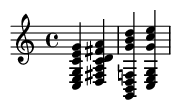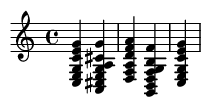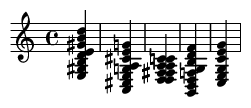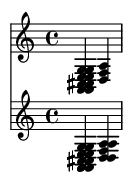Summary:
Secondary dominants are one of the most powerful tools in functional harmony, used to add color, tension, and forward momentum to chord progressions. By temporarily "tonicizing" chords other than the tonic, they create compelling harmonic detours that enrich your musical narrative. This article delves into the theory behind secondary dominants, shows you how to build and use them, provides practical examples across genres, and offers techniques to integrate them into your compositions, arrangements, and improvisations.
Keywords:
Secondary dominants, tonicization, chord progressions, functional harmony, dominant-tonic relationship, V/V, V/ii, circle of fifths, altered chords, modulation, jazz harmony, classical harmony, tension and release, music theory.
Introduction:
In music, the relationship between the dominant (V) chord and the tonic (I) chord is the engine of functional harmony. The V chord's inherent tension creates a powerful magnetic pull toward the I chord, establishing key centers and giving listeners a satisfying sense of arrival and resolution. But what if we could harness that same power to point to other chords in the key?
This is precisely what secondary dominants allow us to do. They are dominant chords that resolve to a chord other than the tonic. This technique, known as tonicization, makes a non-tonic chord sound like a temporary tonic, creating a brief, colorful harmonic excursion before returning to the main key. It’s like taking a scenic detour on a familiar road—it adds interest and excitement to the journey.
From the intricate counterpoint of Bach to the sophisticated harmony of jazz standards, from the timeless songs of The Beatles to contemporary pop hits, secondary dominants are everywhere. Mastering how to hear, build, and apply these versatile chords will unlock a new level of harmonic creativity for any composer, arranger, or improviser.
The Dominant-Tonic Relationship: A Quick Refresher
To understand secondary dominants, we must first be solid on the primary dominant-tonic relationship. In any major or minor key, the dominant chord (built on the fifth scale degree, or V) creates tension that strongly desires to resolve to the tonic (built on the first scale degree, or I).
This pull is driven by two key ingredients, especially in the dominant seventh chord (V7):
- The Leading Tone: The third of the V7 chord is the seventh scale degree. It's only a half step below the tonic note and has a strong melodic tendency to resolve upward.
- The Tritone: The interval between the third and the seventh of the V7 chord is a tritone (an augmented fourth or diminished fifth). This is a highly unstable and dissonant interval that creates harmonic tension demanding resolution. Typically, the two notes of the tritone resolve by moving in contrary motion, either inward or outward by step.
In C major, the G7 chord (G-B-D-F) creates tension that resolves perfectly to C major (C-E-G). Notice how the leading tone (B) moves up to the tonic (C), and the chordal seventh (F) moves down to the third of the tonic (E), resolving the B-F tritone.
What Are Secondary Dominants?
A secondary dominant is a dominant seventh chord that resolves to a diatonic chord other than the tonic. It is the "dominant of" a chord that is not the I chord. We use the notation V/X, which is read as "five of X," where X is the Roman numeral of the target chord.
In a major key, any diatonic major or minor chord can be tonicized. This means we can create secondary dominants for the following chords:
- V/ii (five of two) → resolves to the ii chord
- V/iii (five of three) → resolves to the iii chord
- V/IV (five of four) → resolves to the IV chord
- V/V (five of five) → resolves to the V chord
- V/vi (five of six) → resolves to the vi chord
We don't need a V/I, as that is simply the primary dominant (V). We also generally don't tonicize the diminished vii° chord, because its diminished quality makes it an unstable target. A chord being "tonicized" implies it sounds like a temporary tonic, and diminished chords inherently sound unresolved.
Constructing Secondary Dominants
Building a secondary dominant is a straightforward three-step process:
- Identify your target chord. Let's say we're in C major and want to tonicize the ii chord, which is D minor.
- Think of that target chord as a temporary tonic. If D minor were our tonic, what would its dominant be? The dominant is built on the fifth degree of the scale. The fifth degree of a D scale is A.
- Build a dominant seventh chord on that new root. Build a dominant seventh chord on A. This gives us A7 (A-C#-E-G).
The A7 chord is the V/ii in the key of C major. Notice it contains a C#, a note that is not in the key of C major. This new, "borrowed" note is the leading tone to the root of our target chord (C# leads to D). This temporary chromaticism is the signature sound of a secondary dominant, adding a splash of unexpected color.
Here are all the common secondary dominants in the key of C Major:
| Target Chord (in C) | Secondary Dominant | Chord Notes | Chromatic Note(s) |
|---|---|---|---|
| ii (Dm) | V/ii (A7) | A C# E G | C# |
| iii (Em) | V/iii (B7) | B D# F# A | D#, F# |
| IV (F) | V/IV (C7) | C E G Bb | Bb |
| V (G) | V/V (D7) | D F# A C | F# |
| vi (Am) | V/vi (E7) | E G# B D | G# |
Using Secondary Dominants: Common Progressions
Secondary dominants can be inserted into progressions to create a stronger pull toward their target chord. Here are the most common applications, from most frequent to least.
1. V/V (Five of Five): The Strongest Pull to the Dominant
The most common secondary dominant by far is V/V. It intensifies the arrival of the primary dominant (V), creating a powerful one-two punch leading back to the tonic. In C major, the V/V is D7, which leads to G.

This progression (C - D7 - G - C) is foundational in countless classical, jazz, and pop songs.
2. V/ii and V/vi: Emphasizing Minor Chords
The V/ii and V/vi are often used to add emotional weight and harmonic interest when moving to the ii (supertonic) or vi (relative minor) chords. In C major, E7 (V/vi) strongly leads to Am, while A7 (V/ii) pulls toward Dm.
The progression I - V/vi - vi (C - E7 - Am) creates a powerful, often poignant, shift to the relative minor. You can hear this in songs like "Georgia On My Mind" and Radiohead's "Creep."
The V/ii is a cornerstone of jazz, often used to set up the ubiquitous ii-V-I cadence. The progression I - V/ii - ii - V - I (C - A7 - Dm - G7 - C) expands the final cadence, adding a layer of harmonic sophistication.

3. V/IV (Five of Four) : The "Bluesy" Dominant
In a major key, the V/IV is unique because it's a dominant seventh chord built on the tonic note. In C major, V/IV is C7, which contains a Bb. This added flat seventh gives the tonic chord a bluesy, restless quality that pulls nicely to the IV chord (F major). This move is a staple of blues, rock, and pop, heard in countless songs, including The Beatles' "In My Life."
4. Less Common Uses: V/iii
The V/iii is used less frequently than the others. In C major, it is B7 (B-D#-F#-A), which resolves to Em. Because it contains two accidentals, it can sound more jarring and can temporarily weaken the home key more than other secondary dominants. However, it can be used effectively for dramatic effect or to set up a modulation.
5. Chains of Dominants: The Circle of Fifths
For maximum forward momentum, secondary dominants can be chained together, creating a cascade of resolutions. Each chord in the chain is the dominant of the next, pulling the listener forward. The most common chain follows the circle of fifths.
A classic example in C major would be: E7 → A7 → D7 → G7 → C. This is analyzed as V/vi → V/ii → V/V → V → I. This powerful progression is a favorite device in jazz, musical theater, and classical music.

Technical Considerations: Voice Leading
To get the most out of secondary dominants, pay attention to voice leading. The chromatic notes introduced by these chords are tendency tones that want to resolve in a specific way. Smoothly resolving these tones makes the progression sound logical and satisfying.
- The new leading tone (the 3rd of the secondary dominant) should almost always resolve up by a half step to the root of the target chord. (e.g., in A7 to Dm, the C# resolves up to D).
- The chordal seventh (the 7th of the secondary dominant) should resolve down by step. (e.g., in A7 to Dm, the G resolves down to F).
Here is an example showing smooth voice leading for an A7 (V/ii) resolving to Dm (ii) in C major.

Secondary Dominants vs. Modulation
A common point of confusion is the difference between using a secondary dominant and modulating to a new key. The line can sometimes be blurry, but the main distinction is one of scope and function:
- Secondary Dominants (Tonicization) create a brief, temporary shift. The new "tonic" lasts for only a chord or two before the music returns to the home key's gravity. The goal is to add color on the way to a diatonic chord.
- Modulation is a more structural and prolonged shift. The music establishes a new key as the tonal center for an entire section. This is usually confirmed by a strong cadence (like a V-I) in the new key.
In short, tonicization is a local event; modulation is a regional one.
Practical Applications for Musicians
For Composers and Songwriters
Secondary dominants are your secret weapon for making simple progressions sound more sophisticated.
- Add emotional emphasis: Use a V/vi to make the move to the relative minor more dramatic.
- Break predictability: Take a standard I-IV-V-I progression and insert a secondary dominant. Try I - V/V - V - I (C - D7 - G - C) or I - V/IV - IV - V - I (C - C7 - F - G - C).
- Create smoother transitions: Use secondary dominants as pivot chords to move between sections or to set up a modulation.
For Improvisers
When you see a secondary dominant on a chart, your scale choice needs to change temporarily.
- Outline the chord: The simplest approach is to use the arpeggio of the secondary dominant chord.
- Use the correct scale: The default scale for a V7 chord is the Mixolydian mode. For A7 (V/ii in C), you would temporarily use the A Mixolydian scale (A-B-C#-D-E-F#-G).
- Target the tendency tones: Emphasize the 3rd and 7th of the secondary dominant in your lines, resolving them correctly to the target chord to create strong, melodic phrases. In jazz, you can also use altered scales (like the half-whole diminished or altered dominant scale) over secondary dominants for more tension.
For Arrangers
Secondary dominants are essential for reharmonization—taking a simple melody or progression and giving it a new harmonic treatment.
- Substitute chords: Find places where you can replace a diatonic chord with a secondary dominant. For example, in a C - G - C progression, you can replace the first C with Am, then precede the G with its V/V (D7), creating Am - D7 - G - C (a ii-V-I).
- Add passing chords: Insert secondary dominants on weak beats to create smooth chromatic basslines and add harmonic motion.
Exercises for Mastering Secondary Dominants
1. Written & Keyboard Harmony
Practice building and playing secondary dominants in all 12 major keys.
- Write out the V/V, V/ii, V/iii, V/IV, and V/vi chords for every major key.
- At the piano, play the progression I - V/X - X for each possible target chord (X). For example, in G major, play G → A7 → D (I → V/V → V).
- Practice playing circle of fifths progressions (like the E7-A7-D7-G7-C example above) in several different keys.
2. Ear Training
Train your ear to recognize the distinctive sound of a secondary dominant.
- Play and sing a I-V-I cadence. Then, play and sing a I - V/V - V - I cadence. Listen for the chromatic F# (in the key of C) that "colors" the V/V chord.
- Listen to songs you know and try to spot them. Any time you hear a major chord where you expect a minor one (like an E major chord in the key of C), it's likely a secondary dominant (V/vi).
3. Analysis & Composition
- Analyze the harmony of your favorite songs (The Beatles, Stevie Wonder, and classic jazz standards are great places to start). Find and label all the secondary dominants.
- Take a simple folk song or a diatonic melody you've written and try to reharmonize it using secondary dominants to add interest.
Conclusion
Secondary dominants are more than just a theoretical concept; they are the vibrant threads that add color, momentum, and emotional depth to music. By applying the powerful dominant-to-tonic pull to chords other than the tonic, you can guide the listener on a more engaging harmonic journey, full of satisfying tensions and releases.
Learning to use these chords effectively will elevate your understanding of harmony and unlock more sophisticated options in your writing, playing, and arranging. Start by listening for them, then begin incorporating them into your own music. You'll soon find that this essential technique opens up a whole new world of expressive possibilities.
References:
-
Aldwell, E., & Schachter, C. (2018). Harmony and Voice Leading (5th ed.). Cengage Learning.
-
Kostka, S., Payne, D., & Almén, B. (2017). Tonal Harmony (8th ed.). McGraw-Hill Education.
-
Levine, M. (1995). The Jazz Theory Book. Sher Music Co.
-
Rawlins, R., & Bahha, N. (2005). Jazzology: The Encyclopedia of Jazz Theory for All Musicians. Hal Leonard.
